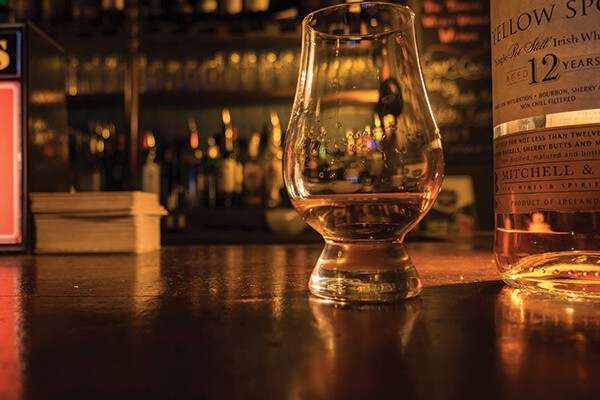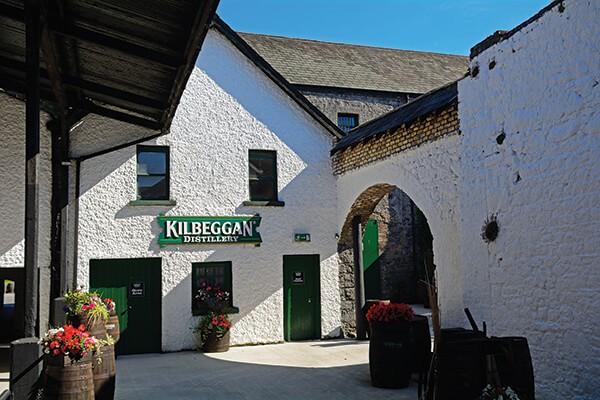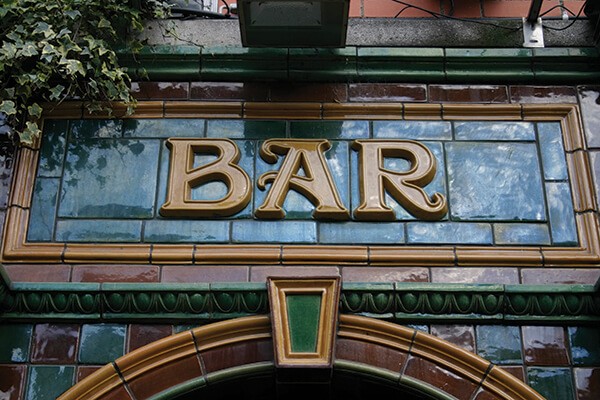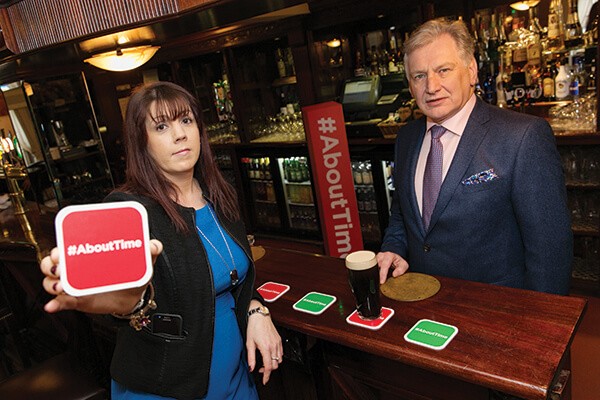Efforts to promote Ireland as a food tourism destination have been
underway for a number of years. Now the craft beer and Irish whiskey sectors
are lobbying to ensure that their products have a starring role in campaigns to
promote the island of Ireland’s tourism offering. Maev Martin reports
On December 7th, the Irish Whiskey Association launched its Irish Whiskey Tourism Strategy in the Irish Whiskey Museum on Grafton Street. The Independent Craft Brewers of Ireland were hot on their heels with an event just a stones throw away in Porterhouse Central on Nassau Street where they launched proposed legislation which they believe will boost craft beer tourism.
Irish whiskey is now the fastest growing spirit drink in the world. According to a report published by the Irish Whiskey Association in December 2016, Irish whiskey experienced double digit growth and record exports of 2400m in 2015. Global sales of Irish whiskey have been growing by double digits since the mid-1990s. The IWA’s strategy sets out how Ireland can become the world leader in whiskey tourism by 2030. The strategy forecasts that the future of Irish whiskey tourism is dependent on a collaboration of local communities and state agencies supporting the growth of Irish whiskey distilleries and visitor centres around the island. It proposes innovative ideas, including the establishment of an all-island whiskey trail that will attract a significant number of tourists to Ireland, similar to the Bourbon Trail in Kentucky, which attracts nearly a million tourists every year. It highlights the importance of working with tourism bodies to develop the necessary infrastructure to facilitate growth, and recommends the development of a hospitality embassy network connected to the Irish whiskey trail. It believes that this will make it easier for visitors to undertake specialist whiskey tours, while extending the benefits of whiskey tourism to local businesses and cultural hubs around each distillery. For example, the Scotch whisky embassy network has created 1,370 jobs and contributes over Stg£43m to the local economy.
“With these support systems and solid foundation structures in place, Ireland will be able to offer an even more distinctive all Ireland-whiskey product with global appeal, setting it on the path to become the world leader in whiskey tourism by 2030,” says Miriam Mooney, Head of the Irish Whiskey Association. “In 2013 there were just four distilleries in Ireland. Today there are 16 in production and 13 in planning in 18 counties across Ireland. With national and local government support, Irish whiskey tourism has the potential to grow from 653,277 visitors every year up to 1.9 million visitors by 2025, spending an estimated 11.3bn every year.”
Speaking at the launch of the whiskey tourism strategy, Chairman of the Irish Whiskey Association, and CEO of Walsh Whiskey Distillery, Bernard Walsh said that the growing success of Irish whiskey internationally and an outstanding whiskey visitor performance to date means Ireland has the potential to become the world’s number one whiskey tourism destination. “But to become the number one whiskey tourism destination in the world, Ireland will have to compete against its biggest rival, Scotland,” he said. “We have 653,000 visitors coming to Ireland’s whiskey visitor centres. Bearing in mind that we have only had five key visitor centres, we are just finding our feet. In Scotland, on the other hand, their visitor numbers are 1.4 million. One in every five visitors to Scotland goes to see a distillery during their trip. They’ve got 109 distilleries, with about 60 of those having a visitor centre, so we’re ahead of the game in terms of the numbers we’re getting to visit the few distilleries we have. There’s a great opportunity to become number one in the world very quickly, but in order for the industry to grow we need more distilleries, new tastes, and variations.” Bernard also pointed out that our current excise rates mean that a bottle of Irish whiskey that costs 142 in Ireland costs just 127 in the US. “This makes no sense in the context of encouraging whiskey tourism,” he says. “Also, new proposals under the Public Health Alcohol Bill will restrict the new entrants and smaller distillers that are needed to promote sustainability through depth and diversity in the Irish whiskey category and so stymie growth in the sector.”
Meanwhile, whiskey producers in Northern Ireland are backing the call by the IWA for an internationally-marketed whiskey trail, similar to Ireland’s tourism-focused Wild Atlantic Way and Ancient East. Old Bushmill’s Distillery in Co Antrim, the world’s oldest licensed whiskey distillery, already attracts around 150,000 visitors annually and has plans to create a new interactive visitor centre as part of an Stg£30m investment in Ireland’s historic distillery, now owned by Jose Cuervo, the market leading Mexican tequila producer. Echlinville, Northern Ireland’s most recent licensed distillery and Ireland’s only single estate whiskey, recently opened a visitor centre at Kircubbin, Co Down. “Our visitor centre is proving increasingly popular especially with international tourists,” says Echlinville’s founder and Managing Director Shane Braniff. “We’d certainly welcome an initiative to develop an all-Ireland whiskey trail. It would be great for the industry and for the wider economy here.”
The Craft Beer ‘Hopportunity’
Having announced the legislation the previous week, Alan Kelly TD officially launched the Intoxicating Liquor Bill 2016 (Breweries and Distilleries) at Porterhouse Central on Nassau Street on December 7th. The Bill aims to boost craft beer tourism in Ireland by removing a major regulatory barrier for breweries, microbreweries, cider makers and distilleries. The Intoxicating Liquor (Breweries and Distilleries) Bill 2016 would allow these businesses to sell their own produce to tourists and other visitors on site, which is not the case under current licensing laws.
“Microbreweries are in operation in 23 of the 26 counties and many of these distilleries, breweries and microbreweries are also major tourist attractions that welcome visitors and offer guided tours, and owners say there is a substantial demand for craft beer tasting on site,” said Alan Kelly. “However, the ability to fully capitalise on this potential for ‘craft-beer tourism’ is being hampered by current licensing regulations, which require producers to have a pub license or an off-licence to sell their produce, made on site, to tourists and visitors. For example, can you imagine a situation existing in Italy, France or Spain, where tourists visiting vineyards are prevented from purchasing wine at the end of their tour? This was the most common issue highlighted by microbreweries as a barrier to development in a recent report for the Independent Craft Brewers of Ireland and Bord Bia. The legislation that I am proposing would rectify that, and be of enormous benefit to the smaller scale and local producers in particular, as well as small batch distilleries and cider makers.”
The Bill includes safeguards such as time restrictions of between 10am and 6pm for sales, and fines to ensure owners don’t sell alcohol that is not brewed on site. And there’s a clause preventing the license holders from applying for the types of exemptions and/or extensions to opening hours that pubs and clubs, for example, can apply for. “The objective here is simple- to remove a regulatory barrier to growth and support an expanding industry in Ireland,” he said.
The Intoxicating Liquor Bill 2016 (Breweries and Distilleries) was read in the Dáil on Thursday, March 23rd. “The second stage debate in the Dáil went well,” says Gráinne Walsh of Metalman Brewing Co. “It received unanimous support – everyone in the Dáil is interested in seeing the Bill go forward – and it has now passed to the committee review stage, at which point amendments will be proposed. Speaking in the Dáil on March 23rd, Joan Burton expressed a desire that everyone move the legislation along as quickly as possible, so we are optimistic that the legislation may be in place before the Dáil breaks up this summer. We are cautiously optimistic that, given the support behind it, the government will move the Intoxicating Liquor Bill 2016 (Breweries and Distilleries) through as quickly as possible because it is great for tourism, great for jobs and great for rural Ireland.”
Speakers at the December 7th launch who endorsed the proposed legislation included John Mulcahy of Fáilte Ireland and food writer John McKenna, as well as a panel of Irish craft brewers, cider makers and distillers that included Gráinne Walsh and Seamus O’Hara, Chief Executive of Carlow Brewing Co.
Like the craft beer brewers and distillers in the Republic of Ireland, craft brewers in Northern Ireland are campaigning for a change in the region’s licensing laws to help the industry’s continuing growth. They want to be able to sell online, from their own premises, and at the many farmers’ and food markets across Northern Ireland. They want to be able to sell freely alongside other artisan food producers, without a special licence. The region currently has almost 40 craft breweries producing a wide range of ales, beers and stouts for the local market, with several selling in the Republic of Ireland, Great Britain and further afield. The campaign to modernise the licensing laws is being supported by Food NI, the region’s food promotion body, as well as Hospitality Ulster.





